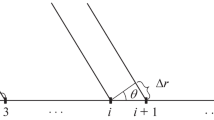Abstract
We propose an optimal algorithm for separating signals with angular manipulation from interference of any type, which is based on the space-time procession of signals. The basic characteristics of such a separator are studied by the method of numerical simulation for different types of antennas with two and three spacing branches: the dependences of separation efficiency on the angular spacing of the signal and interference sources, on the power of signals received, on the separator parameters, on the interference and signal types, etc. It is shown that the considered adaptive receiver can suppress interference efficiently in an ideal communication channel.
Similar content being viewed by others
References
R. A. Monzigo and T. U. Miller,Adaptive Antenna Arrays: Introduction to the Theory [Russian translation], Radio i Svyaz’, Moscow (1986), p. 448.
C. M. Hacket,IEEE Trans.,AES-17, No. 17, 234 (1981).
R. S. Fittind and G. H. Pesinger, “An Adaptive Compensator of Interference Signals,” USA patent No. 4105977, Applied on 03.10.77, Published on 08.08.78, Bull. No. 2, 973.
Additional information
Radiophysical Research Institute, Nizhny Novgorod, Russia. Translated from Izvestiya Vysshikh Uchebnykh Zavedenii, Radiofizika, Vol. 40, No. 3, pp. 378–395, March, 1997.
Rights and permissions
About this article
Cite this article
Metelev, S.A., Shishkin, Y.V. Optimal spatial separator of signals and interference in radio communication channels. 1. Numerical simulation. Radiophys Quantum Electron 40, 247–258 (1997). https://doi.org/10.1007/BF02676349
Received:
Issue Date:
DOI: https://doi.org/10.1007/BF02676349



